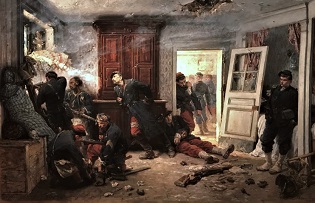The Eighteenth Annual Graduate Student Symposium in Nineteenth-Century Art, co-sponsored by the Association of Historians of Nineteenth-Century Art (AHNCA) and the Dahesh Museum of Art was held virtually on September 25–26, 2021. Ten participants, representing future directions for nineteenth-century art history, presented their dissertation research. After prolonged deliberation because of the uniform high quality of the presentations, the jury awarded two Dahesh Prizes of $1000 each, funded by the Mervat Zahid Cultural Foundation. The awardees, Lieske Huits of the University of Cambridge and the Victoria & Albert Museum, and Sean Kramer of the University of Michigan, will repeat their presentations and discuss their projects at an AHNCA/Dahesh Virtual Salon in December, date TBA.

Lieske Huits presented “Excellent Modern Ornaments, Models of Ancient Production: The Art Journal’s Illustrated Catalogues and the Logic of Appropriation in Nineteenth-Century Revival Jewelry.” She discussed the jewelry of John Brogden, described as both modern ornaments and models of ancient production, and explained how these seemingly opposed descriptions could coexist for nineteenth-century art-manufactures. Using The Art-Journal’s illustrated catalogues of the world exhibitions, she examined the language surrounding revival and adaptation of style in the nineteenth century.
Huits is a PhD candidate in the History of Art at the University of Cambridge in collaborative partnership with the Victoria and Albert Museum. Her Arts and Humanities Research Council-funded research project, “A New Visual Narrative of Nineteenth-Century Historicism” reconsiders the concept of historicism in the decorative arts, focusing primarily on the reception of historicist artifacts in nineteenth-century illustrated print media. She obtained her BA cum laude in the History of Art and Architecture from the Free University of Amsterdam, and her Research MA cum laude in Arts and Culture from Leiden University. She has previously received research grants from the Netherlands Interuniversity Institute for Art History in Florence and the Leiden University Fund’s International Study Fund. Her research interests include historicism and revival styles in the decorative arts and architecture of the nineteenth century, the world exhibitions as a place of taste-making and style discourse, and the display of historicist objects in museums of decorative arts.

Sean Kramer presented “Heroism and Difference: Regarding the Indigenous Soldier in Alphonse de Neuville’s The Last Cartridges (1873).” He examined the presence of a tirailleur algérien [Algerian light infantryman] in Alphonse de Neuville’s iconic Franco-Prussian War canvas, The Last Cartridges, in which Neuville transformed the figure into a synecdoche of the so-called indigenous troops, and gave him an intriguingly prominent role in an image celebrating French martial bravery in defeat.
Kramer is a doctoral candidate at the University of Michigan where he is completing his dissertation, “Military Manhood: Visualizing the Common Soldier in French and British Art and Culture, 1871–1914,” which focuses on imagery of soldiers produced in different media and addresses issues such as masculinity and military medicine, on the one hand, and race and imperial expansion, on the other. He received a B.A. and an M.A. from The University of Kansas. His research has been supported by the University of Michigan’s Rackham Graduate School, the International Institute, and the Museum of Art (UMMA), as well as the Yale Center for British Art. His essay, “Undressing the Army: Hygiene and Hierarchies in Eugène Chaperon’s The Shower in the Regiment (1887),” will appear in the edited volume Male Bonds in Nineteenth-Century Art (Leuven University Press, 2021). He also curated the exhibition, Oh, honey… A queer reading of UMMA’s collection, which is currently on view at the University of Michigan Museum of Art through February 2022.


